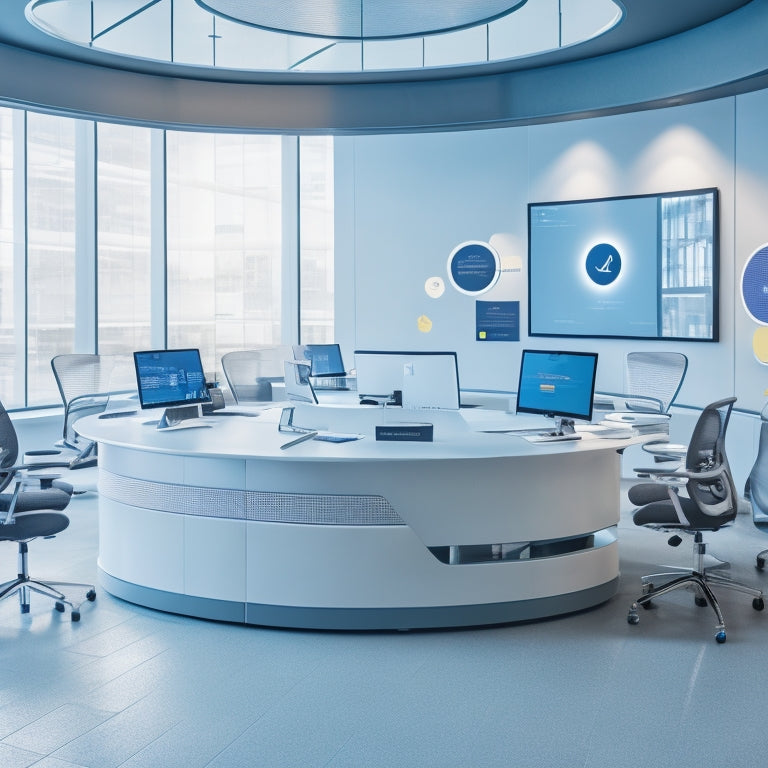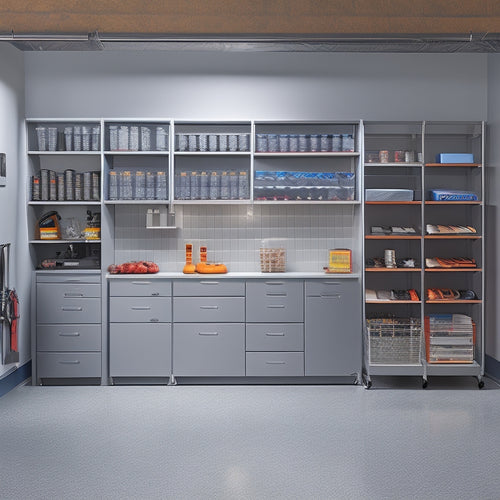
Revolutionizing Workplace Efficiency With Lean Tools
Share
Implementing Lean tools and principles is a proven strategy for revolutionizing workplace efficiency by streamlining processes, reducing waste, and increasing productivity. By eliminating non-essential tasks, streamlining workflows, and organizing tools, organizations can create a more efficient and effective work environment. Visual communication tools and 5S principles can further optimize operations, while a strong Lean culture encourages employee engagement and empowerment. By adopting these strategies, organizations can achieve significant improvements in efficiency, quality, and customer satisfaction. To reveal the full potential of Lean tools and take your organization to the next level of efficiency, explore the key elements of a successful Lean transformation.
Key Takeaways
• Implementing Lean principles reduces waste, enhances customer value, and streamlines processes for high-quality products and services.
• Organizing tools with designated places, labels, and signs saves time, increases productivity, and maintains a smooth workflow.
• Visual communication tools, such as color-coded charts and signs, facilitate clear understanding, reduce errors, and promote continuous improvement.
• The 5S principle eliminates waste, optimizes workflows, and increases productivity by sorting, categorizing, and organizing essential items.
• A Lean culture transformation requires leadership commitment, open communication, and employee empowerment to drive sustainable success and increased productivity.
Lean Principles in Action
Implementing Lean principles in the workplace leads to a significant reduction in waste and a notable enhancement of customer value, resulting in a more efficient and effective work environment. By integrating Lean principles, organizations can streamline processes, eliminate non-value-added activities, and focus on delivering high-quality products and services.
Effective Lean training is essential in equipping employees with the necessary skills and knowledge to identify and address inefficiencies. A well-organized workplace is a vital component of a successful Lean implementation, enabling employees to work efficiently and effectively.
Organizing Tools for Efficiency
Properly organized tools are essential to maintaining a smooth workflow, reducing downtime, and increasing overall productivity in a Lean-driven workplace. A well-organized workspace layout enables employees to quickly locate the tools they need, saving time and effort.
To achieve this, consider the following strategies:
-
Assign a designated place for each tool, ensuring that it is easily accessible and visible.
-
Use tool organization supplies such as pegboards, shadow boards, and foam kits to keep tools off the floor and organized.
-
Label and sign each tool station, making it easy for employees to identify and retrieve the tools they need.
Visualizing Workplace Communication
In a Lean-driven workplace, effective visual communication is essential for streamlining processes, enhancing collaboration, and promoting a culture of continuous improvement.
Visual communication tools such as color-coded organization charts and signs facilitate clear understanding among team members. A well-organized visual management system enables employees to quickly identify and address issues, promoting an efficient workplace.
Implementing visual communication tools like 5S Posters, Kanban Card Racks, and Vinyl Chart Tape enhances clear communication, reducing errors and increasing productivity. By leveraging these tools, organizations can create a transparent and efficient work environment, driving continuous improvement and fostering a culture of innovation.
Streamlining Operations With 5S
By integrating 5S principles into daily operations, organizations can eliminate waste, optimize workflows, and create a more efficient work environment. This Lean tool is designed to streamline operations, improve workflow, and reduce waste.
By implementing 5S, organizations can:
-
Sort and categorize essential items, eliminating unnecessary ones that contribute to waste.
-
Set in Order and organize remaining items in a logical and accessible manner, reducing search times and increasing productivity.
-
Shine and maintain a clean and organized workspace, reducing errors and improving overall efficiency.
Building a Lean Culture
Regularly, organizations that successfully implement Lean principles and tools find that a cultural transformation is necessary to sustain long-term efficiency and continuous improvement. Building a Lean culture requires a shift in mindset, where employee engagement and empowerment become essential.
Leadership commitment is vital in driving this cultural transformation, as it sets the tone for a culture of continuous improvement. By fostering an environment of open communication and collaboration, organizations can encourage employees to identify areas for improvement and develop solutions.
This, in turn, leads to a culture of ownership and accountability, where employees are motivated to drive efficiency and productivity. With a strong Lean culture in place, organizations can harness their full potential and achieve sustainable success.
Frequently Asked Questions
How Do I Measure the Effectiveness of My Lean Implementation?
Did you know that 71% of companies report significant improvements in productivity after implementing Lean tools? To measure effectiveness, track Key Indicators and Performance Metrics such as lead time, throughput, and defect rates to quantify the impact of your Lean implementation.
What Are the Most Common Obstacles to Implementing 5S Principles?
Implementing 5S principles often faces obstacles such as employee resistance to change and cultural barriers, which can hinder adoption and sustainability, emphasizing the need for effective communication, training, and leadership support to overcome these challenges.
Can Lean Tools Be Adapted for Use in Small or Startup Businesses?
Can lean tools be adapted for small or startup businesses? Yes, by prioritizing scalability concerns and resource constraints, businesses can tailor lean tools to fit their needs, leveraging flexibility and adaptability to drive efficiency and growth.
How Often Should I Conduct 5S Audits to Maintain Workplace Organization?
Conduct 5S audits regularly to maintain workplace organization, ideally monthly, to verify that visual controls are effective and identify areas for improvement, with quarterly reviews to assess audit frequency and adjust as needed.
Are There Any Industry-Specific Lean Tools and Resources Available?
According to a recent study, 75% of companies report improved productivity after implementing industry-specific Lean tools. Healthcare solutions, such as customized 5S supplies, and Manufacturing software, like production scheduling software, cater to unique industry needs, optimizing efficiency and streamlining processes.
Related Posts
-

Building a Garage Storage System With Built-Ins
You're about to build a garage storage system with built-ins that fits your unique needs, starting by evaluating your...
-

Bin Garage Storage Ideas for Maximizing Space
You can greatly maximize your garage's storage space by utilizing vertical space with ceiling storage bins, stacking ...
-

What Tools Do I Need for a DIY Wall Organizer
You'll need a variety of tools to complete a DIY wall organizer project. Essential measuring tools include a tape mea...


